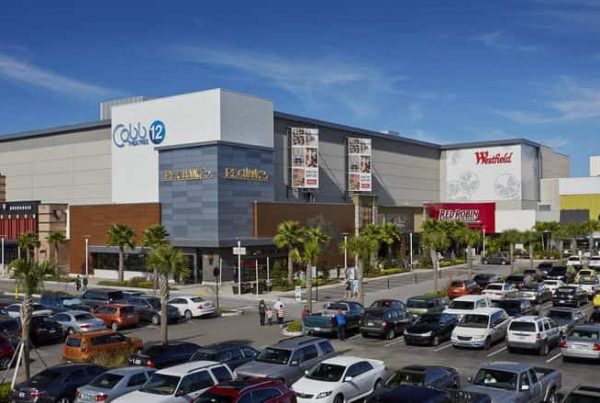Nick Pipitone
March 9, 2022
If we’re looking at the effects of the broken supply chain on commercial real estate, it’s best to start at the beginning. And it all begins with the onset of the pandemic and its impact on manufacturers. Michigan Maple Block Company is a good example. On March 24, 2020, the Michigan Maple Block Company furloughed most of its 56 workers at its plant in Petoskey, Michigan. The company decided to do so after its state enacted a stay-at-home order. It had only been a couple of weeks since the World Health Organization characterized COVID-19 as a pandemic, alarmed by the spread and severity of the mysterious new infectious disease. A month later, in late April, Michigan Maple Block Company decided to shut down the factory for good, closing a plant that had manufactured cutting boards and industrial tabletops since 1881.
The venerable Michigan Maple Block Company was far from the only manufacturer in the U.S. or in the world that closed, either temporarily or permanently, in those frantic first few weeks of the pandemic. The U.S. manufacturing workforce shed 1.3 million jobs in April 2020, including temporary layoffs, and the blunt economic trauma of COVID-19 lockdowns forced many factories to shutter for good. Across the world in China, a wave of city-wide lockdowns shut factories and ports in the world’s second-largest economy proved to be a bigger concern. Eighty-one percent of companies worldwide rely on Chinese suppliers, according to a survey conducted in February 2020 by German supply chain consultant Kloepfel Consulting. As COVID-19 spread out of mainland China into the rest of the world in early 2020, supply chain disruptions multiplied.
If you assumed that supply shortages of everything from cars to coffee would end with the lockdowns and stay-at-home mandates, you might be in for a bit of a surprise. “I don’t think things will return to normal as we’ve known them over the last couple of decades,” Alex Capri, a visiting senior fellow at the National University of Singapore’s business school, told CNBC in March 2020. “We are in a completely new era now, and globalization as we’ve known it in the past is over.”
The supply chain disruptions have been a constant conversation topic in the past two years, and their impact has extended to all areas of commercial real estate. The industrial sector has been the focus for many real estate investors, where an insatiable demand for warehouse space and last-mile logistics has led to record-low vacancies and rising rents. Large retailers like Amazon and Costco have taken steps to purchase their own warehouse space to cope with record-high rents. Other real estate sectors, like multifamily buildings and offices, have also taken big hits. Construction projects have seen delays and rising materials costs, stressing property owner budgets.
Eighty-six percent of building developers are reporting delays or materials shortages, and 66 percent are reporting delays in permitting and entitlements, according to the NAIOP, the Commercial Real Estate Development Association. It’s uncertain when the supply chain disruptions will ease, though some say the situation is improving already. Others have a more pessimistic take and think the volatility of the post-pandemic world means that supply chain messiness may simply be part of our future.
Supply chains are complex global networks, and experts warned that their configuration before the pandemic could cause widespread instability if any big shocks occur. These supply chain experts turned out to be correct, and we’re facing a reckoning. Commercial real estate owners will continue to feel the effects of these disruptions throughout 2022.
Not in my neighborhood
Demand in the industrial real estate sector had been strong before the pandemic, but the supply-and-demand imbalance caused by the pandemic’s effects on the supply chain created a tremendous growth period. The boom in e-commerce and consumer goods spending has amplified the lack of warehouse space available, which municipalities have historically been stingy about allowing on their turf. Finding land to build on has proved difficult. Of the 390 MSF of new industrial construction in the pipeline in the U.S., 70 percent is already pre-leased, according to Prologis. In coastal areas near large metro markets, vacancy rates are incredibly low, and rents are shooting through the roof. For example, industrial vacancy rates in California’s Inland Empire and Northern New Jersey markets are at 1.2 percent and 2.2 percent, respectively.
“I think we still have a pretty significant runway in terms of rent growth for industrial and in terms of it being a really strong-performing asset class,” said Rachel Elias Wein, Founder and CEO of WeinPlus, a commercial real estate investment advisory firm. “I think one thing that’s worth giving pause is that it’s certainly no secret this is a high-performing sector, so is it possible people get too excited about it? Trees don’t grow to the sky, and there is an end to this. There could be oversupply if we’re not careful.”
Melissa Alexander, Vice President of Foundry Commercial, has been an industrial broker for about 15 years, and she said the supply chain disruptions have had pros and cons for industrial. “Demand is up incredibly, faster than I’ve ever seen it,” Alexander said. “But it’s really tough to find land to build product. If you don’t have that entitlement for land, municipalities aren’t going to give it to you. So, the demand is there, but there’s a lack of supply, and demand has ticked up so quickly that construction can’t keep pace.”
Alexander said the result is simple economics: it’s become a landlord’s industrial market, and rental rates are rising faster than she’s ever seen. In the Nashville region where she works, Alexander said industrial rents had risen an “unheard-of” 20 percent in the last year. Alexander added that more companies are coming into the Nashville area from outside the region, like the West Coast, competing for the same space with local companies. Many small to mid-sized industrial tenants have no choice but to pay the exorbitant rents. But on a national level, larger companies, such as Amazon, Target, and Kroger, have increasingly sought to buy warehouse space instead of lease, as they ramp up e-commerce operations and save money in the long run. The 25 largest U.S. retailers bought about 38 million rentable square feet in new industrial space in 2020, according to CoStar Group Inc., a commercial real estate data provider. In the past decade, it was the largest industrial real estate land grab by big U.S. retailers. The supply chain bottlenecks of the past two years have companies like Target and Amazon shifting from a ‘just-in-time’ mentality to a ‘just-in-case,’ and they want to store as much inventory as they can.
The need for land to build on is a major concern for industrial brokers like Alexander. Even pre-pandemic and before the supply chain crisis, land prices rose sharply for the development of warehouses, both for ‘first-mile’ and ‘last-mile’ facilities. Northern New Jersey was the most active warehouse construction market in 2017, and the average price per acre for a typical large parcel of prime warehouse development land that year was nearly $1.8 million. That number is a 17 percent land price increase compared to 2016, according to CBRE. While more warehouse land is needed, groups like New Jersey Future, a nonprofit promoting sensible and equitable growth, warn about the effects of ‘warehouse sprawl’ on communities. The Port of New York and New Jersey’s major facilities in Newark, Elizabeth, and Bayonne make warehouse land incredibly valuable in New Jersey, and some residents worry about companies gobbling up finite land. In nearby Lehigh Valley, Pennsylvania, the area lost 25 percent of its farmland between 1997 and 2017 to new warehouses, according to the U.S. Department of Agriculture. Some municipalities may want more warehouses because of the property tax windfall, but average citizens rail against them because of increased freight traffic and noise in local neighborhoods.
Given the increased need for last-mile and urban logistics, though, many average Americans may have to get used to having a warehouse nearby. “People have to realize that if they want to click the ‘buy’ button and you want that thing on your doorstep in a certain amount of the time, there’s going to need to be more neighborhood and urban distribution centers,” Alexander said. “If you look around your room, I don’t think you can pick one thing that’s around you that didn’t come from a warehouse.”
Forty-five percent of online shopping customers expect a two-hour delivery window or less, according to a study by Convey. These sky-high customer demands and increased e-commerce orders are forcing companies to refine their last-mile logistics, which is often the least efficient part of the supply chain but carries 28 percent of the cost, according to Gensler. Last-mile delivery models are based on seven-to-nine-mile delivery ranges. But, many e-commerce companies find it challenging to buy or lease warehousing near customer densities and the optimal traffic conditions. Zoning, building code, and building condition issues complicate matters, but underperforming big-box retail stores have recently become ideal for last-mile warehouse conversions. Urban warehouses provide a significant competitive advantage if they can be developed. And with space at a premium, Alexander says one trend is multi-story warehouses that maximize costs and limited space. Sometimes, Alexander says the last-mile warehouse land in Nashville is more valuable than the building itself. She doesn’t see the demand for these facilities slowing down anytime soon, either.
“Because of supply constraints, we’re seeing the single biggest boom ever observed for industrial real estate,” Alexander said. “But on the flip side, if we cannot suffice for that supply and demand for warehouse space, then we’re going to have major issues down the road. I think one of the takeaways is how can we create more opportunities for developers for industrial buildings?”
Expect delays
Despite the headaches of finding land to build, the supply chain’s impact on industrial real estate has been mostly positive for investors and landlords. The story has been one of shortages and delays for other real estate assets like offices and multifamily buildings. For real estate builders and developers, construction projects take longer to complete and cost more because of product shortages and price spikes. For example, suppose a property owner wants to do a roof replacement. The contractor can expect a 180-day lead time when placing an order for roofing insulation compared to just two weeks before the pandemic, as Todd Sachse, CEO, and founder of Detroit-based Sachse Construction, told ReBusiness Online.
Meanwhile, the cost of raw materials like lumber, steel, plywood, and even glue is all up dramatically compared to 2020. All told, there was an average of a 26 percent increase on building construction projects in 2021, according to Business Insurance. Building projects slated to be finished at $1 million have routinely been pushed up to $1.5 million because of delays and cost overruns. Despite the challenges, most building construction pipelines are still robust, and there’s an uptick in development activity. But the delays and price increases have been migraine-inducing.
“What we’re seeing is completely unprecedented in terms of the supply chain,” said Carlos Valverde, Vice President of Real Estate Development at Silverstein Properties, Inc. “We’ve awarded over the past two years about $800 million worth of construction contracts, and every single one of them has had an issue because of COVID and what’s going on with the supply chain.”
Valverde said steel supply is a prime example of the disruptions facing real estate and construction developers. He said the steel price has increased by 20 percent over the past couple of years, and being able to source the raw material has been one of Silverstein Properties’ most significant challenges. In the early days of the pandemic in 2020, the closing of borders and factories affected Silverstein’s ability to send inspectors to Canada and Europe to check factory production of their critical raw building materials. Valverde said not being able to schedule those ‘surprise’ check-ups was a significant difficulty. “It’s just been challenging,” Valverde said. “We’ve gotten more into the weeds of how our suppliers run their business than we care to because we’re trying to anticipate so much of what’s going on.”
Contracts with suppliers and developers protect Silverstein for the most part, Valverde said, but it’s been complicated when they fail to perform. When contractors have complications, he said they try to help them as much as possible without hurting themselves. Helping the contractors includes talking to their key suppliers and ironing out problems. They also try to have their contractors use ports closest to their factory to avoid issues.
“It would be naïve of us to say the supply chain issues will clear up in the next quarter or two,” Valverde said. “But we’re doing everything we can to look ahead and anticipate where there might be an issue or shortage. The key thing is building relationships with contractors and suppliers that stand the test of time.”
Valverde and other real estate professionals are doing their best to tackle the challenges, but a perfect storm of disruptions has led to considerable slowdowns in building construction. About 30 percent of building materials imported to the U.S. come from China, according to the National Roofing Contractors Association, and the slowdown in receiving those materials has forced many contractors to seek goods from local suppliers. But local manufacturers haven’t been able to keep up with the demand, leading to postponed or canceled projects, according to Kris-Wire, a national wire manufacturing company.
The explosion in materials costs has passed on to real estate developers and property owners, who have sometimes reconsidered projects or hit the pause button because they’ve gone so over budget. Another factor adding to all this is a construction labor shortage. About 709,000 construction workers were laid off in April 2020 when the pandemic first hit, representing 10.8 percent of the nation’s total construction workforce. Now, almost two years later, many of those workers haven’t come back, and some building contractors fear they never will. The Associated Builders and Contractors estimates the construction industry needs to fill about 480,000 positions right now. The labor shortage has only further increased costs and delayed building projects.
Building developers have gotten creative in ways to combat these issues. Creating more thorough lists of needed materials has been important, given that many materials face shortages, and it’s not as easy right now in the ordering process. Building Information Modeling (BIM) software is one way to organize materials lists electronically, pinning down the needed goods to exact locations in the building project. Developers and contractors are also ordering materials as early as ever, possibly months in advance or sometimes even years in advance for larger projects. Ordering earlier allows developers to lock in prices and avoid unpleasant surprises caused by shortages, especially from materials coming from overseas. Some developers have also created a designated role for logistics managers, who oversee all vendor purchase orders. These logistics managers get the materials delivered to off-site storage and take careful inventories, organizing everything until they’re ready to be shipped to the construction site.
All of these methods are more expensive than what developers and contractors have been used to, but they’ve become more necessary because of the unpredictability of the supply chain. A dedicated logistics team and warehouse space for building materials, though, may save some costs in the long run by avoiding more expensive just-in-time orders when materials costs are so high. These organizational methods can also significantly impact avoiding delays to the building timelines and project completion.
Getting on the winning side
So, when will supply chains go back to normal? And if there’s no going back to pre-pandemic normality, when will the disruptions at least slow down? Wein, the commercial real estate investment advisor, believes we already hit peak supply chain disruption in late 2021 when people couldn’t stop talking about the backlog in ports on the West Coast, and the supply chain crisis was constantly in the headlines. But Wein also says getting back to some sense of normalcy will depend largely on consumer spending habits, which have shifted dramatically during the pandemic.“It depends on how permanent this increased spending on goods becomes,” Wein said. “Americans are spending 20 percent more on goods right now than we were pre-pandemic. That’s just crazy, and the system can’t handle that. If Americans go back to spending in ways similar to pre-pandemic, this will sort itself out. But the longer we maintain this elevated spending on goods, the longer the strain remains on the supply chain, and it’ll lead to more companies building resilience in their supply chains.”
Supply chain ‘resilience’ is a big buzzword right now, but Gad Allon, Professor of Operations, Information and Decisions at the University of Pennsylvania, says building resilience is expensive, and very few firms are willing to do it long-term. “Resilience means you build excess inventory, you hold excess capacity, or you work with multiple suppliers. Many firms are unwilling to do this primarily because very few customers are willing to pay for resilience. I hear companies say they want their supply chains to be resilient, but they have very short memories.”
Building resilience into supply chains would be a positive for the industrial real estate market, as companies gobble up warehouse space and onshore manufacturing capabilities if they can find the land to build. But as Allon said, talk of resilient reforms could die down when supply bottlenecks start to clear up. Building resiliency into supply chains involves paying for more warehouse space, holding onto more inventory, working with additional suppliers, and working with more local suppliers, who are often more expensive because of higher labor costs. These things can undoubtedly ease supply chain problems, but its costs must be passed off somewhere, either in higher prices for finished goods or diminished profit margins. The more likely scenario is the holy grail of resilience will fade away when the supply chain issues ease up, and the reality of the economics of the situation takes over again.
Predicting when the supply chain will normalize is mostly a fool’s errand. In 2022, recent virus outbreaks caused by the Omicron variant have affected factory output in places like China. There’s one thing supply, its volatility, and the 2020s could be a decade marked with the volatility of the ongoing pandemic, increased natural disasters from climate change, and political instability. Another lurking factor is a developing Chinese energy crisis, according to Panos Kouvelis, director of the Boeing Center for Supply Chain Innovation at Washington University in St. Louis. Rising energy prices have forced Chinese energy companies to place restrictions on heavy manufacturers there, and these costs will eventually be passed on to American and global consumers.
America and much of the rest of the world have long over-relied on Chinese and Asian manufacturers, and the supply chain disruptions of the past two years have aggravated the situation. Lessening this dependence on Chinese suppliers could mean some onshoring of manufacturing to America to a certain degree, but those costs could be too prohibitive. About 33 percent of C-Suite executives believe the supply chain problems will last for another three years, according to a recent survey by Accenture. In the meantime, we all might have to get used to higher costs, shipping delays, and periodic supply shortages.
The supply chain is a complex network we’ve taken for granted for quite some time. We’ve become accustomed to one-click buying and instant gratification, getting goods delivered quickly and at relatively low prices. But while the supply chain seems invisible sometimes, it’s not, and keeping up that high level of convenience could mean last-mile logistics in our neighborhoods and a host of other changes. The supply chain could very well ease back into its pre-pandemic normal, where companies follow ‘lean’ manufacturing principles and a just-in-time mentality. But maybe not. As the global logistical challenges continue in 2022, it’s also possible the pandemic may have changed the supply chain for good. In commercial real estate, all these disruptions will create winners and losers in the form of rising industrial rents and delayed building construction. So, it’s best to figure out how to get on the winning side now.








